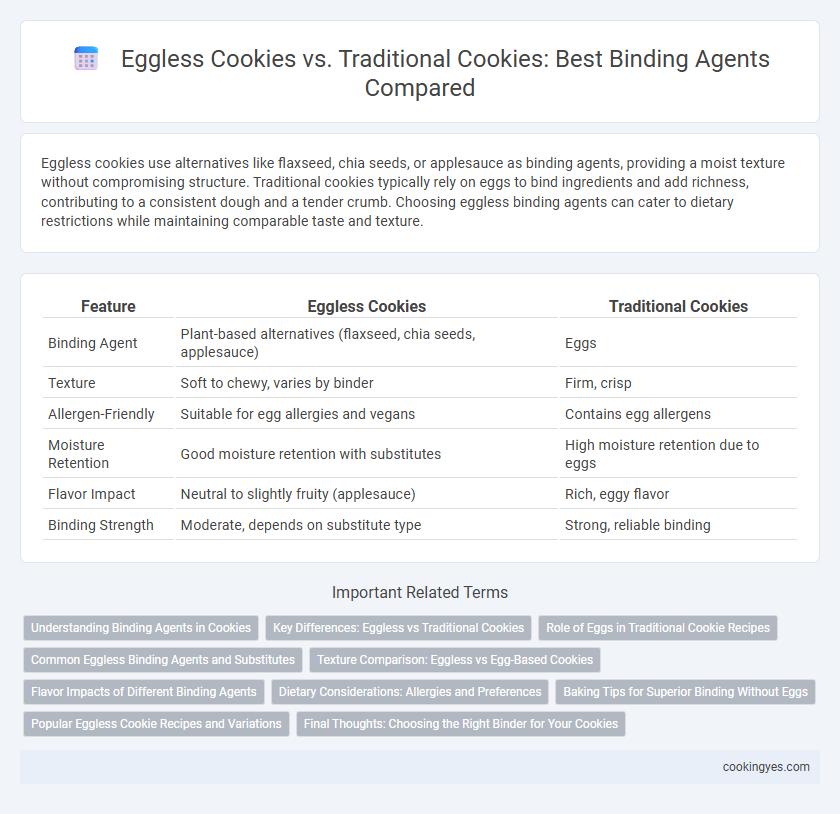Eggless cookies use alternatives like flaxseed, chia seeds, or applesauce as binding agents, providing a moist texture without compromising structure. Traditional cookies typically rely on eggs to bind ingredients and add richness, contributing to a consistent dough and a tender crumb. Choosing eggless binding agents can cater to dietary restrictions while maintaining comparable taste and texture.
Table of Comparison
| Feature | Eggless Cookies | Traditional Cookies |
|---|---|---|
| Binding Agent | Plant-based alternatives (flaxseed, chia seeds, applesauce) | Eggs |
| Texture | Soft to chewy, varies by binder | Firm, crisp |
| Allergen-Friendly | Suitable for egg allergies and vegans | Contains egg allergens |
| Moisture Retention | Good moisture retention with substitutes | High moisture retention due to eggs |
| Flavor Impact | Neutral to slightly fruity (applesauce) | Rich, eggy flavor |
| Binding Strength | Moderate, depends on substitute type | Strong, reliable binding |
Understanding Binding Agents in Cookies
Eggless cookies commonly use binding agents like flaxseed meal, applesauce, or commercial egg replacers to provide moisture and structure traditionally achieved by eggs. Traditional cookies rely on eggs as a natural emulsifier and binder, contributing to the dough's cohesiveness and texture during baking. Understanding these binding agents is crucial for replicating the elasticity and firmness in eggless cookies while maintaining the expected crumb and chewiness of traditional recipes.
Key Differences: Eggless vs Traditional Cookies
Eggless cookies use alternatives like flaxseed, applesauce, or commercial egg replacers as binding agents, whereas traditional cookies rely on eggs for structure and moisture. The absence of eggs in eggless cookies can result in a denser or chewier texture compared to the fluffier and more tender crumb of traditional cookies. Eggless cookies are often preferred for vegan diets and allergy concerns, offering a versatile option without compromising binding efficiency.
Role of Eggs in Traditional Cookie Recipes
Eggs in traditional cookie recipes function as essential binding agents, providing structure and moisture that hold ingredients together during baking. Their protein content coagulates under heat, creating stability and a tender crumb, which is challenging to replicate in eggless cookies. Alternative binders like flaxseed or applesauce offer moisture but often lack the same elasticity and richness that eggs contribute to classic cookie textures.
Common Eggless Binding Agents and Substitutes
Common eggless binding agents in cookies include applesauce, mashed bananas, flaxseed meal mixed with water, and commercial egg replacers, all providing moisture and structure without eggs. Traditional cookies typically rely on eggs for their binding properties, contributing to texture, moisture retention, and leavening. Egg substitutes like chia seeds or yogurt serve as effective alternatives, maintaining dough cohesiveness and ensuring a soft, chewy cookie texture similar to egg-based recipes.
Texture Comparison: Eggless vs Egg-Based Cookies
Eggless cookies typically use alternatives like flaxseed, applesauce, or commercial binders which result in a denser, chewier texture compared to traditional egg-based cookies that provide a lighter, airier crumb due to the emulsifying and leavening properties of eggs. Egg acts as a natural binder and moisture enhancer, giving traditional cookies a soft yet crisp texture, whereas eggless variants may sometimes be more crumbly or slightly gummy, depending on the substitute used. Texture differences largely stem from eggs' unique ability to trap air and bind fats and sugars, which is challenging to replicate precisely with egg substitutes in cookie recipes.
Flavor Impacts of Different Binding Agents
Eggless cookies use alternatives like applesauce, flaxseed, or commercial egg replacers as binding agents, which impart subtle fruity or nutty undertones, altering the cookie's flavor profile compared to traditional eggs. Traditional cookies bound with eggs tend to have a richer, creamier taste and a more familiar, velvety texture. The choice of binding agent significantly influences aroma and mouthfeel, with egg substitutes sometimes producing a slightly denser or chewier bite.
Dietary Considerations: Allergies and Preferences
Eggless cookies use alternative binding agents like flaxseed, applesauce, or commercial egg replacers, making them suitable for individuals with egg allergies or those following vegan diets. Traditional cookies rely on eggs for texture and moisture, which can pose allergic risks and exclude egg-free dietary preferences. Choosing eggless options caters to stricter dietary needs while maintaining the structural integrity needed for quality cookies.
Baking Tips for Superior Binding Without Eggs
Eggless cookies rely on alternative binding agents such as flaxseed meal, applesauce, or mashed bananas to achieve proper texture and cohesion, which traditional cookies typically obtain from eggs. For superior binding without eggs, incorporate 1 tablespoon of flaxseed meal mixed with 3 tablespoons of water per egg replaced and allow it to gel before adding it to the dough. Baking tips include adjusting baking powder slightly and monitoring moisture content closely to maintain the structure and flavor balance in eggless cookies.
Popular Eggless Cookie Recipes and Variations
Eggless cookies use alternatives like flaxseed, applesauce, or mashed bananas as binding agents, providing moisture and structure without eggs. Popular eggless cookie recipes include vegan chocolate chip, peanut butter, and oat cookies, each leveraging plant-based binders for texture and flavor. Variations often incorporate ingredients like chia seeds or aquafaba to mimic traditional egg properties, ensuring a soft or chewy consistency comparable to traditional cookies.
Final Thoughts: Choosing the Right Binder for Your Cookies
Eggless cookies rely on alternative binding agents such as flaxseed meal, applesauce, or commercial egg replacers to achieve structure and moisture retention. Traditional cookies typically use eggs for their superior emulsifying properties, enhancing texture and stability. Choosing the right binder depends on dietary preferences, desired cookie texture, and allergen considerations to ensure optimal baking results.
Eggless cookies vs Traditional cookies for binding agents Infographic

 cookingyes.com
cookingyes.com